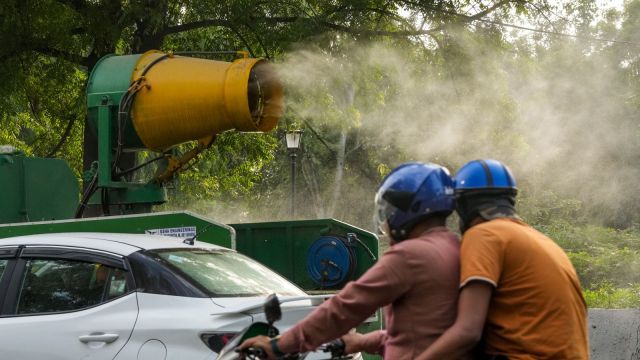Post Dussehra, Delhi sees its first ‘poor’ AQI day mid-October: Here’s why it’s a welcome delay
Delhi Environment Minister Gopal Rai Sunday claimed that Delhi saw clean air during the day, despite the previous day's Dussehra celebrations.
 An anti-smog gun being used to curb air pollution. (PTI)
An anti-smog gun being used to curb air pollution. (PTI)Delhi’s air quality deteriorated from ‘moderate’ to the ‘poor’ category on Sunday, a day after the Dussehra celebrations. Notably, barring the pandemic year, this is the most delayed arrival of a ‘poor’ air quality day for Delhi in October since 2015.
The city’s air quality index (AQI), which was in the ‘moderate’ category until a day before, touched 224 on Sunday, showed data from the Central Pollution Control Board (CPCB).
In 2023, a ‘poor’ AQI of 212 was observed as early as October 6. In 2022, it advanced by a day when AQI fell to 211 on October 5. During the pandemic in 2021, the first ‘poor’ AQI day (284) was on October 16. The CPCB data is available only from 2015.
Forecasts by the India Meteorological Department and the Indian Institute of Tropical Meteorology (IITM) Pune, meanwhile, indicate that the overall AQI is moving back to the ‘moderate’ category in Delhi. The air quality, says the IITM forecast, is likely to be ‘moderate’ until Wednesday. The IMD, in its seven-day outlook, has forecast a partly cloudy sky Monday with mainly clear skies thereafter.
Meanwhile, taking stock of the current situation, the Commission for Air Quality Management (CAQM) in a statement Sunday said it will “closely watch the situation for a day or more”, before invoking Stage I of the Graded Response Action Plan (GRAP) — a set of measures to combat air pollution in NCR and nearby areas.
The commission noted that “owing to episodic events, a rise has been witnessed in the AQI of Delhi since last night till about noon (Sunday)”. The pollutant concentrations showed a declining trend with the AQI expected to improve further, it stated.
Delhi Environment Minister Gopal Rai Sunday claimed that Delhi saw clean air during the day, despite the previous day’s Dussehra celebrations. Delhi has observed 200 days with ‘good’, ‘moderate’, and ‘satisfactory’ air quality days this year by October 12, indicating a possible improvement in pollution levels in the coming months, he stated. “We need the support from the people of Delhi… I urge everyone to download the Green Delhi App,” he added.
Yet, even before the arrival of winter, the national Capital has already witnessed six cases of paddy residue burning from the North Delhi district, the ICAR-Indian Agricultural Research Institute stated. This is the highest number of cases reported between September 15 and October 13 since 2020, data shows.
Three cases were reported in 2020, while 2021 saw no cases. Two cases each were reported during the period in 2022 and 2023. On Sunday, satellites detected 339 residue-burning events in Punjab, Haryana, Uttar Pradesh and Delhi, taking the total count for the same period across the four states to 1,744.







